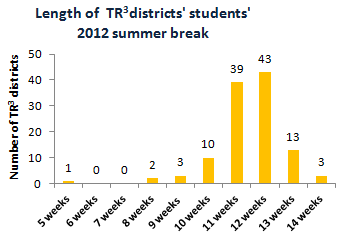Summer break typically lasts around 2 to 3 months, depending on the academic calendar. It provides students with a much-needed break from school, allowing them to relax, recharge, and pursue other interests.
During this time, students can engage in activities such as travel, summer camps, internships, or simply spend time with family and friends. Summer break is a time for students to unwind and enjoy the warm weather before the new school year begins.
It is an essential period for mental and physical rejuvenation, enabling students to return to school feeling refreshed and ready to take on new challenges.
The Rhythms Of Academic Calendars
Academic calendars play a crucial role in the lives of students, educators, and parents alike. These calendars dictate the start and end dates of school terms, as well as the duration of breaks in between. One such break that students eagerly anticipate is summer break. Let’s explore the variations in the duration of summer break across the globe and the typical duration in the United States.
Variations Across The Globe
Summer break varies significantly across different countries and educational systems. While some countries follow a similar academic calendar to the United States, others have distinct variations. Here’s a glimpse into how summer break differs around the world:
- In countries like the United Kingdom and Australia, summer break typically lasts around six to eight weeks. Students get an extended break to enjoy the warm weather and engage in recreational activities.
- In Nordic countries such as Finland and Sweden, summer break can be as long as ten to twelve weeks. This extended break allows students to fully embrace the summer season and spend quality time with their families.
- In Asian countries like Japan and South Korea, summer break tends to be shorter, ranging from four to six weeks. The focus remains on academic pursuits, with students often attending summer schools or participating in enrichment programs.
Typical Duration In The United States
In the United States, the duration of summer break varies across different states and school districts. However, a typical summer break in the U.S. usually spans around ten to twelve weeks. This extended break allows students to relax, recharge, and explore various recreational activities.
During summer break, students often embark on family vacations, attend summer camps, or pursue personal interests outside the classroom. It provides an opportunity for students to engage in experiential learning and develop essential life skills.
While the length of summer break may vary, its significance remains constant. Summer break offers students a chance to unwind, rejuvenate, and prepare for the upcoming academic year. It serves as a well-deserved respite from the rigors of daily classroom learning.

Credit: www.reddit.com
Summer Break Significance
How Long is Summer Break? Summer break holds significant importance for students, typically lasting around two to three months. It provides a well-deserved pause from academic routines, offering a chance to relax and recharge before the next school year. The duration varies by school and region, ranging from late May to early September.
Summer break is a cherished time of the year for students and teachers alike. It is a time to take a break from the rigors of academic life, recharge the batteries, and explore new opportunities. Summer break is a time to relax, have fun, and spend time with family and friends. It has a significant impact on everyone, including students, teachers, and families.
Benefits For Students And Teachers
Summer break provides students and teachers with numerous benefits. For students, summer break is a time to unwind and explore new interests. It is a time to learn new skills, make new friends, and gain real-world experience through internships and volunteer work. Summer break also gives teachers the opportunity to recharge and prepare for the upcoming school year. Teachers can attend professional development workshops, plan new lessons, and spend time with their families.
Impacts On Family Dynamics And Travel
Summer break also has a significant impact on family dynamics and travel. Families can take advantage of the warm weather and long days to plan vacations and spend quality time together. Summer break allows families to reconnect and create lasting memories. It also provides an opportunity for families to explore new places and cultures, which can be educational and enriching.
In conclusion, summer break is a significant time of the year for everyone involved in the education system. It provides students and teachers with numerous benefits, including the opportunity to relax, explore new interests, and prepare for the upcoming school year. Summer break also has a significant impact on family dynamics and travel, providing families with the opportunity to spend quality time together and create lasting memories.
Maximizing Your Summer
Summer break is a cherished time for students and families alike. With the absence of school and the abundance of free time, it’s important to make the most out of this season. By planning productive activities and incorporating relaxation and downtime, you can ensure that your summer is both fulfilling and rejuvenating.
Planning Productive Activities
When it comes to planning productive activities for your summer break, it’s essential to have a clear vision of what you want to achieve. Here are some ideas to get you started:
- Set goals: Start by setting specific goals for the summer. Whether it’s learning a new skill, completing a personal project, or improving your physical fitness, having goals will give you direction and motivation.
- Create a schedule: Develop a schedule that includes dedicated time for your productive activities. This will help you stay organized and ensure that you make progress towards your goals.
- Explore new hobbies: Summer break is the perfect time to discover new interests and hobbies. Consider trying out activities such as painting, gardening, cooking, or playing a musical instrument.
- Volunteer: Giving back to your community not only benefits others but also provides you with valuable experiences and personal growth. Look for volunteer opportunities that align with your interests and values.
Incorporating Relaxation And Downtime
While it’s important to stay productive during summer break, it’s equally crucial to incorporate relaxation and downtime into your routine. Here are some ways to find the right balance:
- Unplug from technology: Take breaks from screens and social media to enjoy the present moment. Engage in activities that promote mindfulness, such as going for a walk in nature or practicing yoga.
- Spend time with loved ones: Use the summer break as an opportunity to strengthen your relationships. Plan outings or gatherings with family and friends, creating lasting memories.
- Read for pleasure: Dive into a good book that sparks your imagination and allows you to escape into different worlds. Reading not only provides entertainment but also enhances your vocabulary and knowledge.
- Indulge in self-care: Prioritize self-care activities that promote relaxation and well-being. This could include taking bubble baths, getting a massage, meditating, or practicing deep breathing exercises.
By maximizing your summer through a combination of productive activities and relaxation, you can make this break a time of personal growth, enjoyment, and rejuvenation. So, start planning your summer today and make every moment count!

Credit: www.nctq.org
Educational Opportunities
Educational opportunities during summer break offer a wide range of options for students to continue learning and growing outside the traditional classroom setting. From summer schools and camps to online courses and workshops, there are various avenues for students to engage in educational activities and expand their knowledge during the break.
Summer Schools And Camps
Summer schools and camps provide structured learning environments in a fun and interactive setting. Students can immerse themselves in subjects like science, art, and coding while participating in outdoor activities and team-building exercises. These programs offer a blend of academic enrichment and recreational opportunities, catering to diverse interests and learning styles.
Online Courses And Workshops
Online courses and workshops offer students the flexibility to pursue their educational interests from the comfort of their own homes. Whether it’s mastering a new language, delving into computer programming, or exploring creative writing, these virtual learning platforms provide a convenient way for students to acquire new skills and knowledge. With a wide range of subjects and levels available, students can personalize their learning experience based on their areas of interest.
Travel And Exploration
One of the most exciting aspects of summer break is the opportunity for travel and exploration. Whether you choose to embark on domestic adventures or international excursions, the summer break provides the perfect time to satisfy your wanderlust and create unforgettable memories. Let’s take a closer look at the various options available for travel during this much-anticipated vacation period.
Domestic Adventures
Exploring your own country can be just as thrilling as jetting off to faraway lands. With a multitude of destinations and attractions to choose from, a domestic adventure allows you to immerse yourself in the beauty and diversity of your own backyard. From road trips along scenic routes to camping in national parks, there are endless opportunities for adventure.
Here are a few ideas for domestic adventures:
- Visit popular tourist destinations such as New York City, Los Angeles, or Las Vegas.
- Explore the stunning natural wonders of the Grand Canyon, Yellowstone National Park, or the Great Smoky Mountains.
- Indulge in beachside relaxation in Miami, Hawaii, or the Gulf Coast.
- Embark on a culinary journey through the food capitals of the country, such as New Orleans, San Francisco, or Chicago.
International Excursions
If you’re craving a more exotic experience, an international excursion might be just what you need. Traveling to different countries allows you to immerse yourself in new cultures, try diverse cuisines, and explore breathtaking landscapes. With so many countries to choose from, the possibilities are endless.
Consider these international destinations for your summer break:
- Discover the ancient wonders of Egypt and marvel at the pyramids and the Nile River.
- Experience the vibrant culture and stunning architecture of cities like Paris, Rome, or Tokyo.
- Relax on the pristine beaches of Bali, the Maldives, or the Greek Islands.
- Embark on a wildlife safari in Kenya, South Africa, or Costa Rica.
Remember to check travel restrictions and requirements before planning your international excursion to ensure a smooth and hassle-free trip.
Whether you choose to explore your own country or venture to foreign lands, summer break offers the ideal opportunity for travel and exploration. So pack your bags, embrace the spirit of adventure, and make the most of this well-deserved vacation.
Summer Jobs And Internships
Summer break is a time for students to relax, recharge, and explore opportunities beyond the classroom. For many, it’s also a prime time to gain valuable work experience through summer jobs and internships. These opportunities not only provide a source of income but also offer a chance to develop essential skills and explore potential career paths.
Gaining Work Experience
Summer jobs and internships give students the chance to gain practical work experience, helping them develop important skills that can’t be learned in a traditional classroom setting. From communication and teamwork to time management and problem-solving, these experiences can be invaluable in preparing students for their future careers.
Exploring Career Paths
Participating in summer jobs and internships allows students to explore different career paths and industries. It provides a firsthand look at what it’s like to work in a specific field, helping students make more informed decisions about their future career goals. By gaining exposure to different roles and responsibilities, students can better understand their interests and strengths, ultimately shaping their career aspirations.
Staying Active And Healthy
Enjoy a summer break of around 2-3 months for kids to stay active and healthy. Engage in outdoor activities, sports, and nutritious eating to make the most of this time. Prioritize physical well-being and mental health during the summer months.
Physical Activities And Sports
Engaging in physical activities during summer break is vital for overall health.
- Participate in sports like soccer or basketball.
- Go swimming or biking for fun exercise.
Mental Health And Self-care
Prioritizing mental health is crucial for a fulfilling summer break.
- Practice meditation for stress relief.
- Engage in creative hobbies like painting or writing.

Credit: www.vox.com
Preparing For The New Academic Year
Preparing for the New Academic Year is an exciting time for students and parents alike.
Setting Goals And Expectations
Establish clear goals for the upcoming academic year to stay focused.
- Set realistic expectations for yourself or your child.
- Create a study schedule for better time management.
Organizing And Supplies Shopping
Organize study materials and create a conducive study space.
- Make a list of needed supplies before shopping.
- Shop for school supplies early to avoid last-minute rush.
Frequently Asked Questions
How Long Is The Typical Summer Break?
Summer break typically lasts around 2 to 3 months, giving students a well-deserved rest from their studies. The exact duration can vary depending on the educational institution and the region.
What Is The History Of Summer Break?
The concept of summer break dates back to agrarian societies, where children were given time off from school to help with harvest. Over time, this tradition evolved into the extended break we know today.
How Can Students Make The Most Of Summer Break?
Summer break presents an ideal opportunity for students to explore new interests, take part in community activities, pursue internships, or engage in volunteer work. It’s also a great time to relax and recharge for the upcoming academic year.
Conclusion
The length of summer break varies depending on the country and educational institution. Generally, summer break lasts for two to three months, providing students with a well-deserved break and an opportunity to engage in extracurricular activities. While summer break may seem long, it is essential for students to take the time to recharge and prepare for the upcoming academic year.
Whether it’s spending time with family or exploring new hobbies, summer break is an excellent time for students to grow personally and academically.


